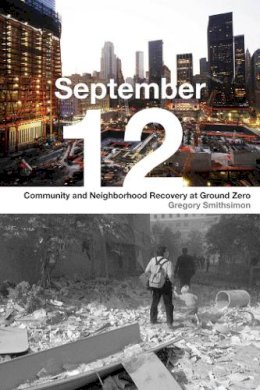
September 12: Community and Neighborhood Recovery at Ground Zero
Gregory Smithsimon
The collapse of the World Trade Center shattered windows across the street in Battery Park City, throwing the neighborhood into darkness and smothering homes in debris. Residents fled. In the months and years after they returned, they worked to restore their community. Until September 11, Battery Park City had been a secluded, wealthy enclave just west Wall Street, one with all the opulence of the surrounding corporate headquarters yet with a gated, suburban feel. After the towers fell it became the most visible neighborhood in New York.
This ethnography of an elite planned community near the heart of New York City’s financial district examines both the struggles and shortcomings of one of the city’s wealthiest neighborhoods. In doing so, September 12 discovers the vibrant exclusivity that makes Battery Park City an unmatched place to live for the few who can gain entry. Focusing on both the global forces that shape local landscapes and the exclusion that segregates American urban development, Smithsimon shows the tensions at work as the neighborhood’s residents mobilized to influence reconstruction plans. September 12 reveals previously unseen conflicts over the redevelopment of Lower Manhattan, providing a new understanding of the ongoing, reciprocal relationship between social conflicts and the spaces they both inhabit and create.
Product Details
About Gregory Smithsimon
Reviews for September 12: Community and Neighborhood Recovery at Ground Zero
Library Journal
"A compelling ethnographic account of how residents of Battery Park City in lower Manhattan came together to heal and rebuild their community after the attack on the Twin Towers on September 11, 2011...commendable as a community study."
Contemporary Sociology
"Scientifically exacting and warmly personal, Smithsimon elucidates the residents struggles from survival to recovery, the coalescence of community groups, and the debates over redevelopment and the Ground Zero memorial. A well-illustrated, critical, yet sympathetic study of privilege and catastrophe that ultimately celebrates the vitality and diversity of a great city."
Booklist
"A valuable addition to the sociology of urban community development and inequality."
D. A Chekki
CHOICE
"In addition to providing a rich ethnographic account of a neighborhood very much in the public eye over the last decade, September 12 introduces several concepts worth of other scholars' attention and study."
Japonica Brown-Saracino
American Journal of Sociology
"A valuable study of economic privilege and spatial exclusion in the shadow of the Twin Towers and the heart of Americas biggest city."
Sharon Zukin,author of Naked City "Smithsimon explores a basic truth: just as there is no community without politics, there is no democratic politics without a multiplicity of spaces in which people can engage each other in debate. This is an outstanding ethnography of the micro-politics of daily life."
Robert Beauregard,author of When America Became Suburban "A fascinating book...[which] observes community life...through the prism of the months following 9/11."
Matthew Fenton
Broadsheet
"What hes really after in September 12, his account of the history of Battery Park City, is a broad analysis of residents political actions to defend their most unusual home...Much of Smithsimons account focuses on that gulf, both geographic and psychological, and the political mobilization of Battery Park Citys resident professionals to keep their neighborhood isolated from those who might wander in across forbidding West Street."
Alyssa Katz
The Nation
